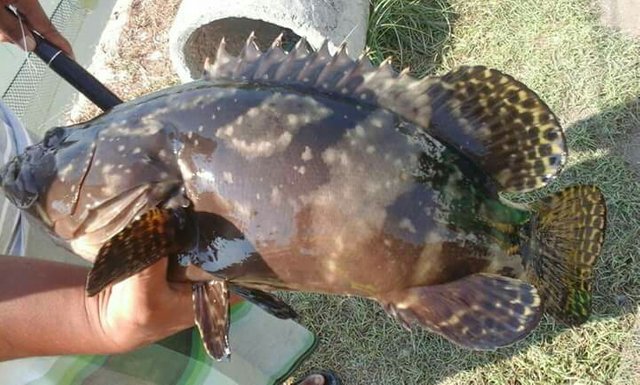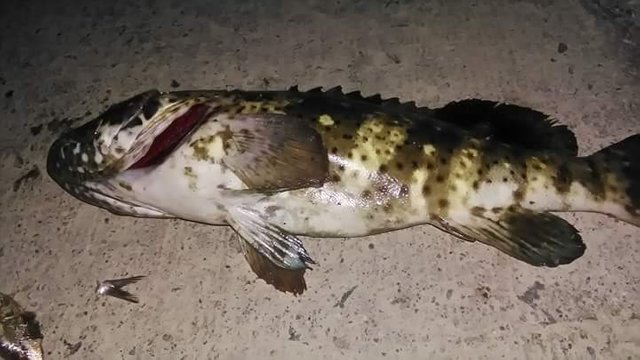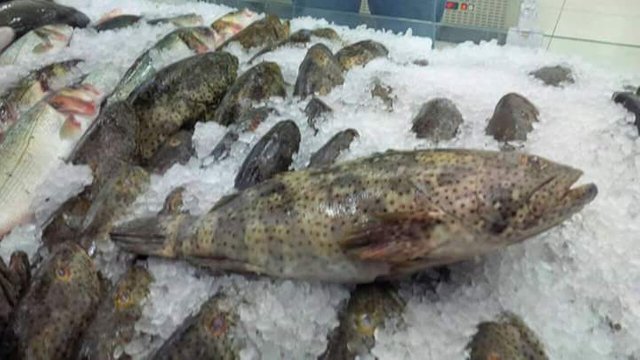Interesting Facts About The Tiger Grouper
I want to share a little knowledge about a predator fish called the tiger grouper (also known as epinephelus fuscoguttatus).

photo credit "By @curiesea
Interesting Facts About The Tiger Grouper:
- The tiger grouper is a fish that lives in the ocean in groups of it’s own kind.
- The grouper is a predatory fish that preys on various types of small fish, animal plankton, squid, and other small animals.
- Cekidot is the tiger grouper’s Indonesian name. In my home in Aceh the tiger grouper is also called a coral grouper. In the Acehnese language it has the name keurape rimung.
- Tiger groupers are sold on the international trade market under the name Carpet Cod or Flower.
According to Wardana, the characteristics of grouper morphology are as follows (Sudirman 2008):
- flat body shape
- The body is smaller than the length and height of the body
- The upper and lower jaws are equipped with strong pointed teeth and a wide mouth
- Oblique in shape with a slightly protruding lower lip above the upper lip
- A rounded tail fin
- A single elongated dorsal fin whose hard flippers are more or less the same as those of soft fingers
- The position of the abdominal fin is under the pectoral fins
- The body is covered in a small, scaly fins of the stenoid.
Habitat
Tiger Grouper usually live in coral reefs located in shallow waters up to 100 meters below sea level. Young tiger grouper generally live in coastal coral waters or along gravel sand with a depth of 0.5 to 3.0 meters. The most favored habitat of tiger grouper is in waters with a sandy base covered in seagrass. Young tiger grouper can also be found in coastal waters near the mouth of a river. After reaching adulthood, tiger groupers move to deeper waters of about 7-40 meters.
Grouper cultivation in the city of lhoksemawe, Aceh is very important in increasing farmers' income. In the grouper farming business of lhokseumawe, farmers have been successful in breeding the fish. Grouper yields can reach 6 tons per one group, with a domestic price of $100 per kilogram and an export price of around Rp $200 per kg.

photo credit "By @curiesea
"The risk of disease is minimal, the price of groupers is also relatively stable. Grouper fish cultivation is still limited and not many other countries are developing it."
Consumers
Types of grouper that are popularly bought by consumers are tiger grouper, mud grouper and duck grouper. Looking at the increasingly high market demand, today's target markets include household consumers, seafood and culinary businessmen, fish traders in traditional markets, as well as collectors and exporters who need grouper stock to meet the needs of foreign markets.
Business Information
Basically grouper are a demersal fish species meaning they live near the sea floor where it is rocky. Usually this type of fish lives among piles of corals or in caves found at the bottom of the ocean. Because of the increasing market demand, grouper are now cultivated by utilizing techniques for fish farming in strategic locations. For example, some people use cement pools with floating cages called Floating Net Keramba (KJA) to cultivate duck grouper.
The cultivation process begins by choosing a good seed (fertilized fish eggs). Usually a good seed comes from a fish that is a size of 2-3 ounces, has a tail, is free of disease, has bright color scales, and is not defective.
Before conducting seed distribution, you should begin helping the first group of grouper to adapt to their environment. It is important that the fish have little stress when distributing the seeds to enhance successful cultivation. The location of the fish should be cleaned and renovated to make it stronger and sanitary.
Seed distribution can be done when the weather is cool (in the morning or evening). Next, make sure the temperature is between 24-31 °C and ensure that there isn't too high a pool density (size 1.5 x 3 x 3 meters contains ± 500 seeds). Grouper are predator fish and you need to consider their cannibalistic nature.
At the time of seed distribution, fish can be fed in the form of pellets. After 3 to 4 days, fish food in the form of pellets can be combined with trash fish (pieces of fish). Feeding should be done in the morning and evening.
The harvest period of grouper is usually adjusted to the size of the fish that the market demands (ie, weighing between 500-1000 grams). In order for fish to not experience stress, you should do the harvesting in the morning or evening. At harvest time, farmers can do it selectively (according to the wishes of the consumers) or overall at the time the market demand is soaring.
After harvesting you need to consider the process of distribution into the hands of consumers. Freshness of groupers must be maintained so that the quality does not decrease. During the transport process you can use plastic drums that contain 2/3 of seawater with the amount of fish density (± 50 heads / drums).

photo credit "By @curiesea
Business Advantages
Cultivating grouper promises a considerable profit. In addition to the high selling prices, grouper have a fairly rapid growth rate meaning business people can meet local market demands and export market needs that are increasing rapidly.
In addition, groupers have a habit of living on sea bottom waters. This turns out to be quite beneficial for businessmen, because when the volume of water at the cultivation site increases (overflows), the fish belonging to this type of demersal do not drift away with the water currents. Grouper fish also do not do much activity in the bottom of the water, thus they avoid being victims of theft. This reduces the risk of losses that threaten grouper fish farmers.
Business Shortages
There are certain advantages but there is also a risk of loss in running a grouper fish farming business. One of the obstacles often faced by business actors is the limited number of seeds. So far, grouper farmers still rely on the seeds they receive from fishermen. Because of this, the seeds from Balai Pembenihan are sizes considered too small and the price is also quite expensive.
In addition, the failure of harvesting successful crops hurts the grouper farmers. Usually the threat of failure due to pests and diseases that cause death of fish, the existence of natural disasters that damage the condition of the ponds, and the threat of fish theft at night harm the grouper farming business.
Marketing strategy
Usually marketing groupers is determined by supply and demand. Usually the grouper sellers market their superior products to the fresh fish traders in traditional markets by depositing them directly to large restaurants that provide a seafood menu. They also sell grouper to agents and collectors who distribute to foreign markets.
So far, the grouper market has not only succeeded in meeting the needs of the national market but has also succeeded in meeting the demand of the international market. Several major countries such as China, Taiwan, and Hong Kong, are the main target of grouper farmers to market their superior products. It is not surprising that today the price of grouper is still high, because the world market demand is very wide open and the production capacity of farmers is still very low.
The Key to Success
To reduce the risk of losses in cultivating grouper, the important thing you need to consider is the selection of seeds that really excel, the selection of proper cultivation location, and maintaining water quality to avoid pollution, pest attacks, and diseases that can cause death in fish. If the facilities and infrastructure in the cultivation of grouper fish can be maintained properly, then the harvested crops will be successful.
Tiger Grouper Classification
Kingdom: Animalia
Phylum: Chordata
Class: Pisces
Order: Perciformes
Family: Serranidae
Genus: Epinephelus
Species: Ephinephelus fuscoguttatus
Other Name: Carpet cod or flower
Sources:
https://en.m.wikipedia.org/wiki/Tiger_grouper
This post has been edited and checked for plagiarism by a member of the @blue-pencil team! Please visit this link to learn more about @blue-pencil.
Thank you for letting a member of the @blue-pencil team help you with your post!
@songsina